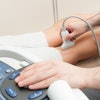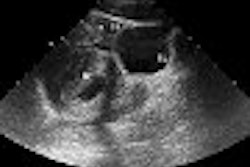A complete lower limb compression ultrasound can exclude clinically significant deep venous thrombosis (DVT), rendering a serial ultrasound exam unnecessary, according to researchers from New Zealand.
The study based the diagnosis of DVT on three components: pretest probability as evaluated by the examining physician, D-dimer blood test, and a complete lower limb ultrasound exam in place of a serial ultrasound exam. The ultrasound exam was carried out if the pretest probability indicated likelihood of DVT and if the D-dimer test results were positive.
"If the D-dimer test is negative, it is well-established in literature that DVT can be excluded, and we do not need an ultrasound exam," said Dr. Rathan Subramaniam from the University of Auckland. He presented the team's results during a presentation at the 2004 RSNA meeting in Chicago.
The prospective study consisted of patients who presented to the emergency department at Waikato Hospital in Hamilton, New Zealand, with suspected DVT between June 2001 and May 2003. From a group of 542 patients, 16 were excluded based on the D-dimer test. The remainder underwent a lower limb ultrasound exam with noncompressible vein being the primary diagnostic criteria for imaging.
According to the results, 413 patients tested negative for DVT. The gold standard for follow-up was the three-month clinical outcome. During this time period, 31 patients returned to the hospital for reasons other than DVT, 364 never returned, and 18 had a repeat ultrasound exam or CT pulmonary angiography (CTPA).
Of the 18 patients who returned to the hospital, one was diagnosed with pulmonary embolism by CTPA.
"The specificity and negative predictive value of a complete lower limb ultrasound to exclude clinically significant DVT is 99.8%," Subramaniam said. The failure rate based on the single false-negative case from among the 413 patients was 0.2%.
Subramaniam used these figures, and results from previous studies, to deduce the failure rate for lower limb compression ultrasound as being between 0.2% to 0.8%. His outcome analysis found this to be comparable to the 0.6% to 1.5% failure rate for serial above-the-knee ultrasound studies (Annals of Internal Medicine, June 2004, Vol. 140:2, pp. 985-991; Thrombosis and Haemostasis, February 2003, Vol. 89:2, pp. 221-227 and pp. 228-234).
The researchers assumed that the 364 patients who were lost to follow-up had no symptoms of DVT during the three-month period, although that may not have been the case. Nevertheless, the group concluded that a negative complete lower limb ultrasound study was more than sufficient for excluding clinically significant DVT.
By N. Shivapriya
AuntMinnie.com staff writer
December 24, 2004
Related Reading
CT for PE: Best test gets better, September 10, 2004
Quick D-dimer test eliminates need for CTA for PE, June 14, 2004
Ultrasound spots DVT after knee, hip arthroplasty, May 31, 2004
Copyright © 2004 AuntMinnie.com



















